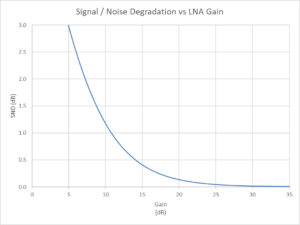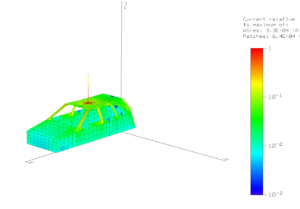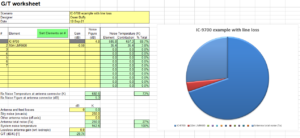The article The oft asked question of how much an LNA improves a 70cm weak signal station solicited some comment on optimal configurations. This article deals with the notion / Rule of Thumb that optimal LNA gain is just sufficient to offset line losses.
This article explains with graphs the relationship between Signal / Noise degradation (see Signal to noise degradation (SND) concept) and LNA gain in the configurations discussed in the original article. See The oft asked question of how much an LNA improves a 70cm weak signal station for documentation of the scenario assumptions.
The critical value for SND is a personal choice, but for the purpose of this discussion, let’s choose 1dB. That is to say that the S/N at the receiver output is less than 1dB lower than the ultimate that could achieved with the antenna system given the external noise environment.
The total line loss in the example configurations was 2.6dB. The model assumes that LNA Noise Figure is independent of LNA Gain, though in the real world, there is typically some small dependence.
Often the choice of LNA Gain drives the choice of a single stage or two stage LNA, which has cost implications.
Terrestrial external noise – 495+5K
Above is a chart showing SND vs LNA Gain. It can be seen that as LNA gain is increased, SND improves rapidly with a knee around 15dB LNA gain above which SND improvement is slower. Continue reading The oft asked question of how much an LNA improves a 70cm weak signal station – Rules of Thumb






